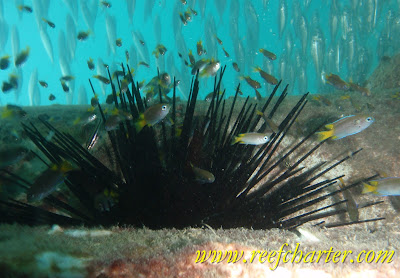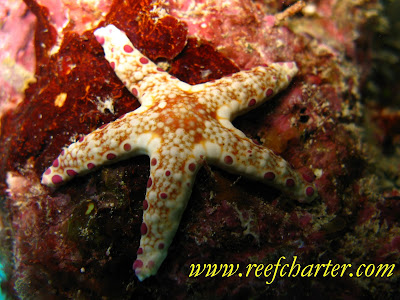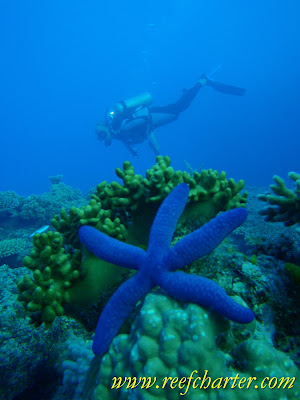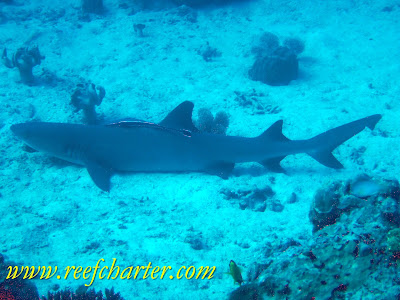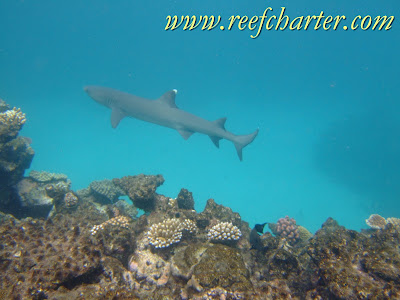The sea urchin is a common site in aquariums and reefs around the world, and the Great Barrier Reef is no different. They abound on the shallows of the reef as well as the deeper areas and walls. Sea urchins are related to sea cucumbers and starfish. Like their cousins they have tubular feet they use to crawl across the reef. They use both water and blood as circulation systems in their bodies and eat mostly algae as part of their diet. When food conditions abound they can reproduce very quickly and therefore reach large numbers in a very short period of time. Likewise when the food sources dwindle they die of in masses just as quickly.
The spines are method of protection against predators but also offers a home to juveniles of smaller fish, offering them protection also. These spines are not dangerous to humans but as always it is best not not play with the wildlife.
Tag: Species-of-the-Reef
Starfish Facts – Species of the Reef
When people think of starfish they think of the typical five armed creature as pictured above and that is correct for the majority of species. But the species is very diverse and starfish can have anything up to 50 arms and come in a large variety of shapes as shown by the feather stars on a previous post. There are so many beautiful members of this family that you can see while you visit the Great Barrier Reef.
The starfish uses water to propel itself. Yes you thought that it used all those little “legs” with suction caps to move along. Well they do and they use water taken in through their body to provide suction to those “legs”. This helps the starfish to appear to float or glide across the surface of the water.
Starfish generally eat their food whole and use their stomachs to digest their food. They eat just about anything they can find on the reef including clams, fish, molluscs, small fish, coral and algae. They can also digest food outside their body by excreting their stomachs allowing them to eat creatures much largers then they could through their mouth.
Sea stars have endoskeletons. The top of the starfish is sensitive to light and the bottom of the starfish is sensitive to different chemical compositions allowing them to “smell” food. Another cool fact is the starfish breathes through it’s feet.
Starfish breed a lot depending on species. The can be hermaphrodites, capable of sexual and asexual reproduction, some are born males and later change into females. One common fact is you cannot tell the difference between the male and females unless you see them during spawning. Reproductive organs are contained within the starfish.
White Tip Reef Shark – Species of the Reef
This is the most common shark spotted by our guests, whether they are snorkeling or scuba diving. The white tip reef shark is a relatively small shark. The average size only measuring about 1.8 metres or 6 feet long. This is one of the best parts of our jobs, seeing people who less then 30 minutes ago were scared about sharing the water with a shark. Now they are seeing them up close and experiencing sharks in their natural habit. Immediately realizing that all the television and movie myths are just that myths. One of our guests last year went from being a nervous snorkeller to scuba diving, and her reason I want to ‘dive with the sharks’.
As you can see from the photo above, all sharks do not require to keep swimming to stay alive, this again is another myth. White Tip Sharks can move water through their gills as they lay still on the bottom. This species of shark tends to hang around reefs for long periods of time, sometimes years. They hunt at night feeding on octopus, fish and other reef creatures, including lobsters and crabs. Not a bad diet. During a night dive, you can observe them slowly swimming along the reef edge looking for that evening snack. Unlike other shark species they do not get into a feeding frenzy.
They are not aggressive towards humans at all, unless provoked and then purely a defensive measure. Humans feeding sharks can lead to confusion and sharks may mistakenly grab the hand that feeds it. Another good reason not to feed the fish, especially the big ones with big teeth.
White Tip Sharks pregnancy lasts about 10-12 months. They give birth to young called pups, this litter can contain anything up to 6 pups. Now how did the white tip shark get its name? Very easy, the white tips on the tops of the fins.
Current populations of white tip sharks are depleting at the rate of about 8% per year, due to unsustainable fishing practices in other parts of the world and its slow reproductive rate.
Swimming and diving with sharks that you must experience to really appreciate. The only way to dispel the myths and see the grace and beauty of a shark it to come and experience it in the sharks natural habitat.
The Barracuda – Fish Species of the Reef
Very popular with scuba divers on our trips to the outer Great Barrier Reef, barracuda are an impressive sight on the reef. The fearsome looking barracuda has a reputation for being and aggressive fish but it is mostly undeserved. They really use their incredible speed to shock and attack its victims of smaller fish. They do not see humans as a meal or as a threat unless actively provoked. They have been known to get aggressive where potential food is involved, another good reason not to feed the fish or support operators that feed fish.
They are often seen in large groups in the early morning or late afternoon hanging around at the back of the reefs. What are groups of barracuda called? Batteries. The can grow to about 1.6 metres or just over 5ft, the guys in the photo above are just over a metre each. They have a large swim bladder (gas filled bladder) they use to control their buoyancy in the water. This allows them to hover perfectly for long periods of time with very little use of energy.
